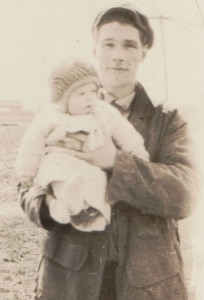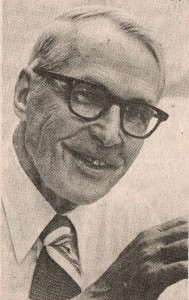Recently I sifted through a box that turned out to be a treasure box because it yielded some great information about a recent ancestor. The ancestor was my father, George Rohrbach (1909-1999), and I was the one who had made the box.
Let me explain. When my stepmother died in 2010, I helped clean out all her and my late father’s belongings. I spent hours going through drawers and boxes and bins, putting many things in the trash or recycling — Mom seemed to love nothing more than newspaper clippings — and also putting some things, not closely reviewed, in a carton to send to myself.
This winter, as part of a long-term project to organize papers and photos, I opened the box and put the recycling bin nearby, certain I had sent myself some things to be discarded.
Among some definite keepers — a rare photo of Dad at 18; his death certificate; clippings of his obituaries — I found some papers and clippings related to his late-in-life college graduation. Dad had quit high school to help support his family. When he was almost 60, he took the GED. He attended Baldwin-Wallace College part time and received a B.S. in geology in 1983, at age 74.
Mom had saved all the clippings of the newspaper articles written about Dad — multiple copies, of course. I was tempted to toss them after reading them; after all, I was there and I remember it all well. But then I remembered that I have children. They weren’t born until after Dad graduated, and although they know he went to college as an older adult, they haven’t read of their grandpa saying, “Going to B-W made me feel like I was young again.” They will want to see all these papers some day, and so will Dad’s other descendants.
Also retained from the box: clippings relating to Dad’s retirement, noting the forty-plus years he spent working for Ohio Edison Company. And the barbershoppers’ photos. Dad sang in a men’s barbershop chorus, the kind where the singers dress in garish outfits and ham it up. One year’s chorus portrait shows them wearing green vests and straw hats; another year’s, mustard-colored suits; another year, farm-themed outfits, with Dad in overalls. These photos are definitely keepers; not only do they tell a part of Dad’s story but they tell a story of twentieth-century America.
I have spent so much time trying to look way back in my family history that I have to remind myself that the recent past, as recent as the 1980s, is also significant. Just the fact that I can remember something doesn’t mean that it’s not important for posterity. I say this to writers of family histories all the time, and I had to say it to myself.
A few of those duplicate clippings got recycled. But everything else was filed away in a folder labeled, simply, “Dad.”
Share this:
About Penny Stratton
A veteran of the book publishing industry, Penny Stratton retired as NEHGS Publishing Director in June 2016; she continues to consult with the Society on publications projects. Among the more than 65 titles she managed at NEHGS are The Great Migration Directory, Elements of Genealogical Analysis, Genealogist’s Handbook for New England Research, and the award-winning Descendants of Judge John Lowell of Newburyport, Massachusetts. She has written for American Ancestors magazine and is a regular poster on Vita Brevis. With Henry B. Hoff, Penny is coauthor of Guide to Genealogical Writing: How to Write and Publish Your Family History; she is also the author of several Portable Genealogists on writing and publishing topics.View all posts by Penny Stratton →

